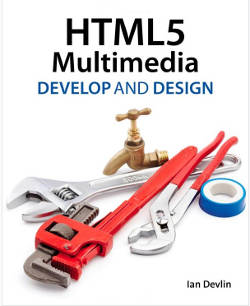| HTML5 Multimedia: Develop and Design |
|
Author: Ian Devlin Web Multimedia is a strange mix of simple and complex. The latest HTML5 audio and video tags make things simple in principle but in practice it can be very messy. Can this book keep in simple from beginning to end? The Develop and Design series of book is targeted at beginners and at building more adventurous web pages. Where other books in the series deal with topics that not everyone wants to get involved in, multimedia has an almost universal attraction. At some point you are going to want to include some audio or video on an otherwise primitive web page. Before HTML5 this would almost certainly mean some sort of plugin to the browser - most likely Flash - and this brought with it many complications. Now HTML5 makes it easy from the point of view of setting up the page, but not so easy for setting up the media. What formats are and are not supported and which you should use is a complex issue. Also the basic tags give you some basic functionality. If you want more then you have to think about JavaScript and CSS. This book looks easy to read. It is colorful, well laid out and with lots of white space. The way that the topics are treated is also simple and, if you are anything but a beginner slow, at least at first.
Chapter 1 starts of with a look at the basics of HTML5 and I'm not really sure this is necessary in a book so focused on a subtopic of HTML5. Even so it might help some readers. Chapter 2 is where the multimedia proper starts and it first describes the way things used to be done, i.e. using Flash and media players in general. Then it moves on to the basic HTML5 tags - audio and video. It also outlines the differences between browsers in they way they treat the tags and the use of the source element to make sure that you provide at least one format that is supported. At the end of this chapter you have just about all you need to know to actually use audio or video tags and you might well be wondering what the rest of the book is going to be about.
The next two chapters take a slower deeper look at the audio tag and then the video tag. You get to find out in detail what a codec is and what browsers support what codecs. There are examples of how to play files on the latest browsers and what to do for legacy browsers. Chapter 5 has a slight change of level in that it is about the JavaScript API and custom controls. This, of course, assumes that you program in JavaScript and, while the examples are fairly simple, you do need to be either reasonably OK with JavaScript or be prepared to look things up. You learn how to create buttons to play, stop, pause, change the volume, fast forward etc. The next chapter shows you how to use CSS to format the video window and place text and other special effect overlays on top of it. Chapter 7 pushes the CSS into transitions, transforms and animations to the video or audio display. This isn't particularly special to the video and audio tags because CSS can be applied to style any HTML element in roughly the same way. Of course the dreaded CSS vendor prefixes are scattered all through these chapters, but there is little the author can do other than warn you where the examples will or will not work. Chapter 8 is about accessibility and covers subtitles and other issues. Chapter 9 is on using video with canvas and this demonstrates simple techniques for displaying video on the canvas element, screen dumping and how to do some simple image processing - converting a color video to gray scale. Chapter 10 describes using SVG with video - mainly using SVG to mask the video display area to produce an elliptical video viewer say. The final chapter looks at some of the latest multimedia technologies including the getUserMedia API, which gives you access to the device's camera. Overall this is a good book if you are a beginner willing to put in some work or an intermediate JavaScript programmer wanting to see some techniques in use. It will disappoint the expert as the pace will be too slow and the examples all fairly obvious applications of general facilities. It achieves its easy to read and understand quality by picking a topic that is nicely self-contained and small enough to be treated well in 250 pages. Being a programmer, for me the best parts of the book were towards the end where the power of canvas and SVG were used to show how you could be more creative. If you want a simple and fairly complete book on HTML5 multimedia then this one comes with a recommendation - but remember to get the goodness out of it you do need to be happy with programming in JavaScript, otherwise you are restricted to the first four chapters.
|
|||
| Last Updated ( Saturday, 06 April 2013 ) |

